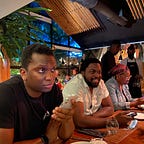Growth, History, Impact and Scale.
Google just sent me a reminder. This week, four years and 6 months ago, I joined Flutterwave, but in hindsight now, it feels like a truly different company.
In 2017, Flutterwave was very infrastructure-based. If you wanted to build something, you came to us, and we gave you the tools to build with. For example, you’re a big business trying to process payments from thousands of customers daily? We had just the API for that.
We knew we could do more. Preaching about our tools wasn’t bringing as much traction as we’d wanted. We also had a lot of tools in our box, and not enough people building with them.
So we set out to build use cases, and show more people how to do it. One of those use cases was a tool to help people create virtual debit cards and make payments across the world; Barter. Dami Busari led this effort.
For another experiment, GB assembled a small team; Nosa was the frontend engineer, Lara was testing, Deji was building the APIs, and I was designing. In about three months, we shipped the second version of Rave.
Rave made it easy for businesses to sign up and receive payments, but we didn’t stop there. In 2017, online payments were still reserved for large and medium-sized businesses, but small businesses found it difficult and that felt so weird. Considering that small businesses make up the bulk of businesses that exist — whether they were little shops or just Instagram accounts — it felt like an opportunity to do something about it.
So, we built a new type of account on Rave; Individual Accounts. Big businesses had a ton of documents required to verify their existence. For small business owners, many of them sole entrepreneurs, a means of identification is sufficient to get started. All you needed to sign up was a valid government ID.
Shipping this was the first time I’d seen the real-world impact of my work at scale. We had about 3,000 merchants before we finished building, and less than two months after we went live, almost 20,000 merchants were using Flutterwave, many of them small businesses.
This project, with me as designer, was when a new idea began to crystallise inside Flutterwave; design can be used as a tool for scale. It also marked the beginning of Flutterwave 2.0. GB began to shape Flutterwave into a design first company. He gave me and by extension, design a chance.
Flutterwave 2.0 has been about building new tools and offering them to people and businesses, scaling rapidly across Nigeria and Africa. Today, what started as a series of experiments now powers about half a million businesses.
A natural outcome of scaling rapidly is that new challenges have come with it. One challenge is clarity for our customers. We’ve done so many things in so little time, and it feels like our customers, the people we build for, don’t have a full sense of what is possible with Flutterwave.
Just as challenges created new opportunities for us and brought us here, it’s also how we get to the next stage.
Flutterwave 3.0 is coming, and it’s not just a better version of what people already know Flutterwave for, it’s also many things that people don’t know Flutterwave for. It’ll be simple, support them at scale, while helping them focus on just the things that matter.
It’s surreal how much can happen in four years, but the next few years? E choke.
